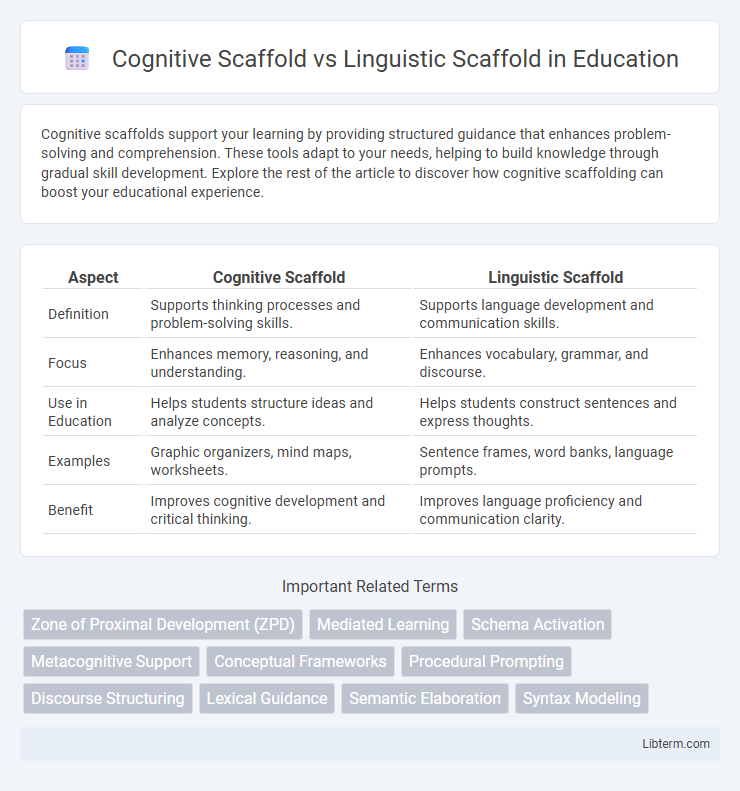Cognitive scaffolds support your learning by providing structured guidance that enhances problem-solving and comprehension. These tools adapt to your needs, helping to build knowledge through gradual skill development. Explore the rest of the article to discover how cognitive scaffolding can boost your educational experience.
Table of Comparison
| Aspect | Cognitive Scaffold | Linguistic Scaffold |
|---|---|---|
| Definition | Supports thinking processes and problem-solving skills. | Supports language development and communication skills. |
| Focus | Enhances memory, reasoning, and understanding. | Enhances vocabulary, grammar, and discourse. |
| Use in Education | Helps students structure ideas and analyze concepts. | Helps students construct sentences and express thoughts. |
| Examples | Graphic organizers, mind maps, worksheets. | Sentence frames, word banks, language prompts. |
| Benefit | Improves cognitive development and critical thinking. | Improves language proficiency and communication clarity. |
Introduction to Cognitive and Linguistic Scaffolds
Cognitive scaffolding supports learners by providing mental frameworks and strategies that enhance understanding and problem-solving skills, while linguistic scaffolding focuses on language structures and vocabulary to aid communication and comprehension. Both types of scaffolds serve as essential tools in educational settings to bridge gaps in knowledge and language proficiency. The integration of cognitive and linguistic scaffolds promotes deeper learning through simultaneous development of thought processes and language abilities.
Defining Cognitive Scaffold
Cognitive scaffold refers to the mental framework that supports and enhances an individual's ability to process, understand, and retain new information through guided learning and problem-solving strategies. It emphasizes developing critical thinking, reasoning, and metacognitive skills by providing structured support tailored to the learner's cognitive needs. This approach differs from linguistic scaffold, which primarily focuses on language development and verbal communication skills as tools for learning.
Defining Linguistic Scaffold
Linguistic scaffold refers to the structured support provided through language to facilitate comprehension and communication, often involving tailored vocabulary, sentence structures, and discourse patterns to aid learners in acquiring new linguistic skills. This type of scaffold enables individuals to bridge gaps between existing knowledge and new linguistic concepts by offering contextualized language models and prompts. In contrast, cognitive scaffolds focus on mental processes and strategies to enhance problem-solving and understanding independently of language use.
Key Differences Between Cognitive and Linguistic Scaffolds
Cognitive scaffolds support learners by enhancing problem-solving skills and guiding thought processes through strategic questioning and prompts. Linguistic scaffolds facilitate language development by providing vocabulary, sentence structures, and discourse cues tailored to learners' language proficiency levels. The key difference lies in cognitive scaffolds targeting conceptual understanding and reasoning, while linguistic scaffolds primarily focus on language acquisition and communication skills.
Theoretical Foundations of Cognitive Scaffolding
Cognitive scaffolding, rooted in Vygotsky's Zone of Proximal Development, emphasizes supporting learners' intellectual processes through guided assistance that gradually fades as competence increases. Linguistic scaffolding, based on sociocultural theory, specifically targets language development by providing contextualized verbal cues and structured dialogue to enhance comprehension and expression. Theoretical foundations highlight cognitive scaffolding's broader focus on metacognition and problem-solving strategies, whereas linguistic scaffolding concentrates on language acquisition mechanics within social interaction.
Theoretical Foundations of Linguistic Scaffolding
Linguistic scaffolding is grounded in Vygotsky's sociocultural theory, emphasizing the role of language in cognitive development through social interaction. It functions as a support system where more knowledgeable others use language to guide learners within their zone of proximal development (ZPD), facilitating meaning-making and language acquisition. Unlike cognitive scaffolding, which targets broader problem-solving strategies, linguistic scaffolding specifically enhances language comprehension and production by strategically shaping input and feedback.
Practical Applications in Education
Cognitive scaffolding enhances students' problem-solving and critical thinking by providing structured guidance tailored to individual learning processes, while linguistic scaffolding supports language development through targeted vocabulary and grammar assistance. In education, cognitive scaffolds are applied via concept maps, mnemonic devices, and step-by-step problem breakdowns, facilitating deeper understanding of complex subjects. Linguistic scaffolding is effectively utilized in language acquisition and literacy instruction through dialogue modeling, sentence starters, and context-rich interactions that improve communication skills.
Benefits of Cognitive and Linguistic Scaffolds
Cognitive scaffolds enhance learning by supporting problem-solving skills, memory retention, and critical thinking, enabling learners to process and organize new information effectively. Linguistic scaffolds improve language comprehension and communication abilities by providing structured language input, vocabulary support, and sentence starters that aid in expression and understanding. Both scaffolds contribute to academic success by fostering independent learning and strengthening cognitive and language development simultaneously.
Challenges in Implementing Scaffolding Techniques
Challenges in implementing cognitive scaffolding include accurately assessing learners' prior knowledge and providing tailored support that evolves with their skill development to prevent cognitive overload or insufficient guidance. Linguistic scaffolding faces difficulties in addressing diverse language proficiencies and cultural backgrounds, making it hard to deliver clear, comprehensible input while promoting language acquisition effectively. Both scaffolding types require careful balancing of support and independence, demanding continuous adaptation by educators to meet students' dynamic learning needs.
Future Directions and Research in Educational Scaffolding
Future directions in educational scaffolding emphasize integrating cognitive and linguistic scaffolds to enhance personalized learning experiences by leveraging adaptive technologies like AI-driven tutoring systems. Research explores dynamic scaffolding that adjusts cognitive load while supporting language development, particularly in multilingual and special education contexts. Studies focus on longitudinal impacts of combined scaffolding approaches to optimize knowledge retention and critical thinking skills across diverse learner populations.
Cognitive Scaffold Infographic

 libterm.com
libterm.com